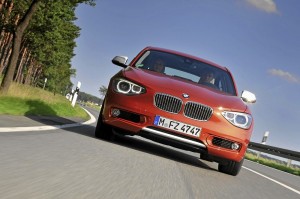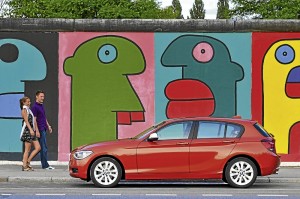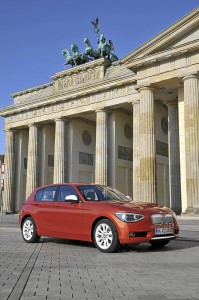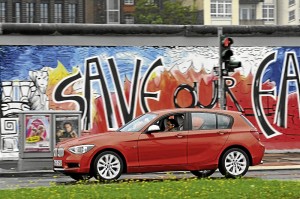Sportier, roomier BMW 1 Series costs less to run
The 1 before: Perfect poise during cornering and steering; joy to drive; a frugal diesel engine; driving position spot on; cramped boot space and tiny rear leg room; the “feel” of the road transmitted directly to the occupants. These were flashes of my mental notes of the BMW 1 Series before boarding the plane from Manila to Berlin, Germany, to get a sneak peek of, and get a first driver’s crack at, the New BMW 1 series—codenamed the F20, which gave me the impression that this one would could be jet-fighter fast.
The 1 after: After three days under the German sky and inside the new BMW 1 Series, I had a new list in my mind: Engine start-stop technology; more choices of driving modes, including a couple of variations for sport, and an Eco drive; increased legroom, and almost 10 percent more luggage capacity; this time, occupants are “protected” from the road harshness; more power, more torque with new turbo charged engines; and then, copy-pasted from the 1 before list, joy to drive is still there, and perfect poise, still, in cornering and driving.
That’s it, end of article. Go buy yourselves the new BMW 1 Series. But wait, there should be more, at least that’s what my editor says. I have to earn my keep, so here goes.
Apparently, the previous BMW 1 Series was good enough to be bought by 1,219,365 customers. Can the new one at least match the impressive sales run of its predecessor?
That’s quite impossible to answer, especially from us Manila-based motoring journalists who had been planed in straight from a 14-hour flight to the Berlin-Tegel airport, and quite literally shoved into the driver’s seat of a spanking new red BMW 1 Series unit at the BMW Pavilion at the airport. Still jet-lagged and stunned by the swiftness of events unfolding before me, I just sat there, holding the steering wheel, thinking how, in the past few months leading up to this late-July trip, the impending introduction of the new BMW 1 had already been creating ripples within online car communities.

STILL the only rear-wheel-driven car in its class, the new BMW 1 Series builds on the strengths of its predecessor, which has sold more than 1 million units worldwide.
Apparently, in a WikiLeaks-like manner, some pictures of the new BMW 1 Series had circulated online, resulting in numerous unflattering comments at the design (“ugly” and “weird-looking” were the adjectives most used). While others ranted, some raved. It became obvious that the new BMW 1 Series would polarize the market.
One thing I can say for certain, though, is that the new 1 series has matured. Rather, its creators have. Realizing that skin-deep beauty is the realm of the cheap, the new BMW 1 Series attempts to rise above the superficiality of looks by going down to where it really matters: Beneath the hood.
Longer, wider, leggier
This is not to say that BMW has neglected the redesign of the BMW 1 Series body. There have been notable changes, namely: The new BMW 1 Series is 85 mm longer, at 4,324 mm; the wheelbase has widened by 30 mm to 2,690 mm; overall width has increased by 17 to 1,765 mm. The rear seats offer 21 mm more legroom, and the luggage compartment has expanded by 30 liters to 360 liters. The height remains at 1,421 mm.
As for the overall design or “look” of the new BMW 1 Series, I was lucky enough to corner French-born Nicolas Huet, BMW senior exterior designer at Munich and one of those chiefly responsible for the F20. He related how the final design of the new 1 series went through the proverbial eye of the needle—gaining the go-ahead only after 20 other competing designers submitted theirs.
Huet explained that the new BMW 1 Series’ overall proportions “follow an instantly recognizable BMW template, with an elongated bonnet, long wheelbase and set-back passenger cell.” The fascia is dominated by the large BMW kidney-shaped radiator grille, boldly shaped headlight units and three-section air intake. The double-round headlights have an accent trim across their tops, and for the first time on a BMW model, the side indicator lights are built into the exterior mirrors.

THE BMW 1 Series boasts best-in-class suspension technology. The almost perfect 50:50 weight distribution helps to translate the dynamic advantages of the rear-wheel drive layout into an exciting responsiveness and a more comfortable ride compared to the predecessor model.
The slightly sloping roof line, sporty, angled rear windscreen and flat side windows give the car a coupé-like feel when seen from the side, while the Hofmeister kink—the low forward bend at the back end of the side windows—extends well into the C-pillar, making the door aperture wider and facilitating entry to and exit from the rear seats.
The bold, characteristic BMW swage line gives powerful emphasis to the shoulder area. It starts at the front wing and rises continuously to the rear lights, with the door handle integrated neatly into it. The wide-set wheel arches reinforce the broad, powerful impression created by the rear of the new BMW 1 Series, and the rear light units, too, are set well apart. Each unit has a raised surround, and the different lights within it are structured horizontally.
The new BMW 1 Series is also the first to be offered with the BMW Sport Line and BMW Urban Line, providing exclusive opportunities for personalization.
Best of both worlds
Going now to the heart of the new BMW 1 Series, Bernhard Lechner, Team Leader of Drivetrain Performance for Small Inline Engines within the BMW Group in Munich, Germany, proudly related that the new 1 Series is capable of saving up to 12 percent more fuel than its predecessor, and still churn out up to 20kW more power. At least that’s what is claimed for the gasoline variants.
The new BMW 1 Series engines work on the TwinPower Turbo technology designed to combine sporty power with exceptionally low fuel consumption and emissions. The diesel models, likewise, extend the advantage that the BMW 1 Series enjoys over its competitors in the compact segment.
The unit I was assigned to, the new BMW 120d, was powered by a 2.0-liter diesel engine with TwinPower Turbo tech. At optimal driving conditions, this variant is touted to result in a fuel mileage of 22 km per liter. For three days, I was able to get a feel of the responsiveness and frugality of this unit, made possible by the reduced engine friction, thermodynamically optimized turbochargers with variable turbine geometry, and next-generation common-rail direct injection with magnetic-valve injectors.
The new BMW 120d marks another major advancement, as maximum output has increased by 5 kW over its predecessor to 135 kW/184 hp at 4,000 rpm, and maximum torque boosted by 30 Nm to 380 Nm between 1,750 and 2,750 rpm. It reaches 100 kph from a standing start in 7.2 seconds, and can reach a maximum speed of 228 kph.
Combined-cycle fuel consumption has been reduced to between 4.5 and 4.6 liters per 100 km, with CO2 emissions of 119 to 122 grams per km (as per EU test figures).
The other unit test driven by my fellow motoring scribes was the four-cylinder, gasoline-powered BMW 118i. The engine was also designed to make it “unusually fuel-efficient,” thanks mainly to High Precision Injection technology.

THE PREMIUM compact BMW 1 Series, an important car for the brand that symbolizes the successful rebirth of German industry, strikes a pose at Brandenburg Gate in Berlin.
The BMW 118i powerplant has an all-aluminum crankcase, with a maximum output of 125 kW/170 hp at 4,800 rpm, and a maximum torque of 250 Nm at between 1,500 and 4,500 rpm. Exceptionally responsive, this one can accelerate from 0 to 100 in 7.4 seconds and go on to reach a maximum speed of 225 kph.
Improved efficiency is reflected in combined-cycle fuel consumption of 5.8 to 5.9 liters per 100 km and CO2 emissions of 134 to 137 grams/km.
On the move
For half a day on the first day in Germany, I drove the 120d manual transmission version on a portion of the ADAC safety driving center at Linthe, southwest of Berlin. Sprawled on 25 hectares are 6 km of tracks, 14 driving modules and 4 watered dynamic pads— making it the biggest and most modern test drive facility in Europe. There were high-speed drives on wet and dry surfaces, and around pylons to test the 1 series on sharp curves. The 120d’s good weight distribution made it an agile vehicle, like an equally proportioned athlete for its 50-to-50 front-rear axle, which is unique in its class (normally it’s 60 to 40, the 60 being on the front axle) and which gives it a good neutral steering direction. My fellow journalists liked how the new BMW 1 Series steered, even citing that BMW engineers have finally mastered an electric steering system to give the driver real feedback—an asset that has made the 1 Series a notch higher than others in its class.
The responsiveness of the new BMW 1 Series is also largely due to the combination of a powerful, reliable braking system and DSC (Dynamic Stability Control), which is fitted as standard. Proven features such as ABS (anti-lock braking system), DTC (Dynamic Traction Control), CBC (Cornering Brake Control) and DBC (Dynamic Braking Control) are now augmented with braking assistance, fading compensation, brake drying, hill assist, and, in DSC Off mode, an electronic rear axle differential locking system.
After the ADAC track drive, action shifted to Berlin with its spotless (but mostly wet) road conditions. There, the 120d, albeit driven a bit more “domestically” compared to the track drive, felt like a conditioned athlete just warming up for the races.
There was also a countryside driving, on the sleepy town of Linthe, where the manual tranny 120d proved once and for all that the harshness of the ride was a thing of the past, and I was able to appreciate the relaxing views of verdant fields, windmills, and the quiet woodlands, even on stretches where the road was unpaved.
I also found myself having fun with another 120d, this time in automatic tranny, weaving through 121 km of zigzag roads and on a motorway with no general speed limit on the way to Berlin, and on a long but rainy 140-km route to the airport from my hotel.
Start-stop
The newest fuel-saving feature of the new BMW 1 Series initially sounded counterproductive. The Start-Stop technology took me a while to get used to. The realization that my engine “dies” during idling times on stoplights, at first elicited a mini-panic in me. But no sooner than I took my foot off the brake pedal, the engine resurrected. A whole day of city driving eased my mind, though for this technology, I would prefer that I drove the A/T rather than the M/T.
Another apprehension pops up. Doesn’t stopping and starting an engine so many times on short intervals actually consume more fuel? BMW engineers quickly explained that starting conventional engines did, indeed, require more fuel to start than just let it idle for a few minutes, more so if it was a “cold start” (turning the engine on after letting it rest overnight). But the new BMW 1 Series, they point out, needs less fuel for a “warm start” than if it were idling for a few minutes while waiting for a green light.
The moment the engine stops, the aircon’s power needs are also reduced. The engine has a special starter system, the layout of which has also been redesigned so as to accommodate the substantially increased number of times the starter system would be activated by the Start-Stop technology. BMW engineers have also re-thought the wet battery technology, virtually replacing this with a special battery that holds more potential energy.
The drive through Linthe also gave me the opportunity to finally toy around with the four drive modes: Sport, Sport Plus, Comfort and Eco Pro. Though I think I overdid the shifts, doing so every few seconds, not enabling the vehicle to really offer me any useful feedback. Well, you can only do so much in just a few hours of driving in such a technically endowed car. The bottomline was, I did find the essence of joyful driving with the new BMW 1 Series.

